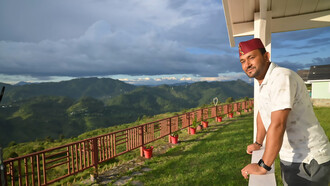I handled tarantula, swam among piranha and sand sledded down gigantic dunes in Peru. Of course, I visited the UNESCO World Heritage site of Machu Picchu, as well. Until I was actually in Peru, though, I had no idea of the extent of its biodiverse riches.
Peru is best known for the ancient Inca ruins of Machu Picchu. Few appreciate that the Amazon Rainforest extends into Peru and that miles of desert ripe for adventure exist within Peruvian borders.
The Amazon
Peru’s Amazon Rainforest makes up more than half of the country’s land. Only Brazil is home to a larger portion of this natural wonder. While on the water, frolicking pink dolphins treated us to a show.
Amazonian outfitters will take guests fishing for piranha, which we later got to taste at dinner. The piranha were disappointingly bony, but their meat was succulent. Contrary to movie depictions, piranha did not feast on our flesh when we swam among them. Nor did the tarantulas we fondled take the occasion to bite any of us.
Peru is home to the largest number of bird species in the world, and the Peruvian Amazon contains almost half of all bird species in Peru. Hummingbirds, parrots and toucans sometimes greeted us along our travels. I was not lucky enough to see sloths, jaguars or anacondas in the jungle, but playful monkeys, who sometimes were adept at pickpocketing, were common.
Many of the indigenous villages welcome travelers to observe their customs and to buy their handicrafts. Shamanic healing is common in this region, as well.
The ancient pearl of Machu Picchu
Machu Picchu, known as the “Lost City of the Incas,” is on many travelers’ bucket lists. Located in the Andes Mountains, it is considered one of the New Seven Wonders of the World, in part because it is one of the few major pre-Columbian ruins found nearly intact. Filled with impressive architectural feats, the views are captivating. Some llamas roam the grounds freely, and people are often observed making pilgrimages to the sacred site.
Machu Picchu is the most visited tourist attraction in Peru. It can be reached via a railway from nearby Cuzco or by hiking the picturesque Inca Trail. Cuzco is a delightful city, high in the Andean mountains. It, too, earned its declaration as a UNESCO World Heritage Site. One of the oldest continuously inhabited cities in the Western Hemisphere, it boasts delicious cuisine, pleasing plazas surrounded by cobblestone streets, a vibrant art scene, interesting archaeological sites, stellar views and a multi-layered indigenous and colonial history. Many travelers stop in Cuzco before visiting Machu Picchu to acclimatize to the high altitude.
Another nearby site of note is Rainbow Mountain, a stunning mountain range whose colors were revealed after the ice that covered it melted and mixed with minerals in the soil. The altitude makes for challenging hikes, but the payoff is worth it. In addition, the nearby Maras Salt Mines are worth a visit. There, community families continue to harvest salt from thousands of pre-Inca handmade salt pools.
The Sacred Valley also is a major tourist destination. Colorful handicraft markets offer gorgeous textiles at inexpensive prices. The Valley’s breathtaking landscape attracts travelers from around the world for adventure tourism, trekking and spiritual endeavors.
The wild desert
My favorite outing was to the vast desert of Huacachina, home to the biggest sand dunes on the continent. We reached it via a harrowing dune buggy ride by a driver who seemed to relish our fright while he made daring turns and accelerated over the tops of high perches. I was surprised to arrive at a small village built around a palm-fringed oasis. We then took our time climbing up and sandboarding down the dunes, which reached heights of up to 500 meters (1,600 feet).
A cool lake is nestled among the dunes, where visitors may swim and paddle. A gorgeous picnic at sunset was one of the most sublime experiences of my life. The tour guide surprised us by placing sumptuous pillows and rugs in a semicircle at the top of a dune that afforded a spectacular view of the sunsetting. Music and a campfire enhanced the culinary delights served as we toasted to an unforgettable adventure.
Peru’s capital city
Lima is the gateway to Peru’s treasures. Well-preserved colonial architecture abounds. A visit to the Larco Museum’s extensive gallery of erotic pottery is a unique experience. Peru’s award-winning restaurants are impressive. World’s 50 Best Restaurant-winner, Central, features a 17-plus course meal that features ingredients from every altitude of the country, from 20m below sea level to 4,000 meters up in the Andes Mountains. Ceviche, of many combinations, is one of the country’s most famous dishes. I also thoroughly enjoyed the picarones, or Peruvian doughnuts, sold at stands in many of the city’s parks.
A giant adobe pyramid, Huaca Pucllana, constructed between 300 and 700 A.D., looms next to cafes and residential neighborhoods in Lima. It provides a fine history appetizer for those heading to Machu Picchu.
Paragliding and surfing along the scenic coasts are common outings in Lima. I had not before seen a motorized paraglider, and it definitely got my adrenaline soaring.
Perhaps the only thing I did not enjoy was the Andean delicacy of Cuy, which is a guinea pig. I just could not get over the intact face reminiscent of some of the pets of my youth.














